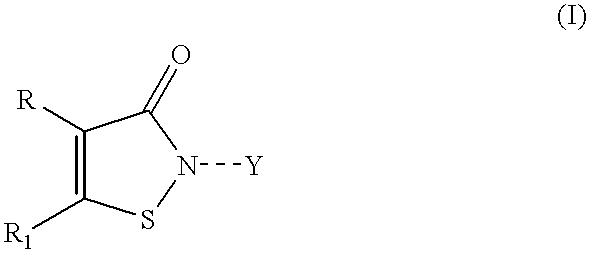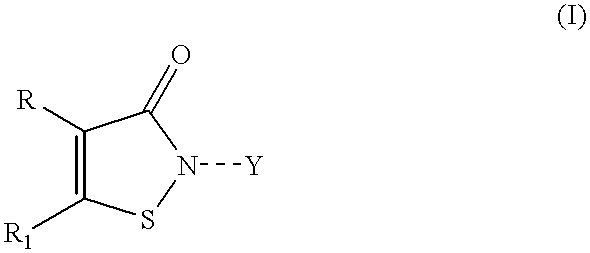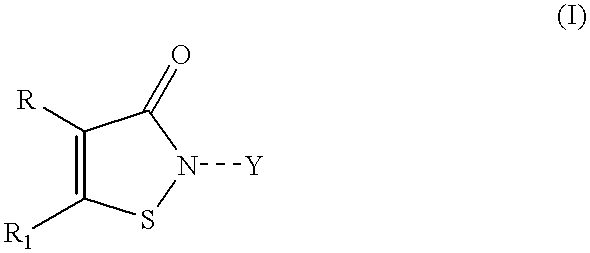Controlled release compositions
a composition and composition technology, applied in the field of solid compositions, can solve the problems of loss of the safening of the 3-isothiazolone compound provided by the solid composition, the inability to control the the inability to provide controlled release of the 3-isothiazolone compound, etc., and achieve the effect of low water solubility
- Summary
- Abstract
- Description
- Claims
- Application Information
AI Technical Summary
Benefits of technology
Problems solved by technology
Method used
Image
Examples
example 2
The amount of 3-isothiazolone compound released from each controlled release composition was determined according to the following general procedure. A weighed amount of controlled release composition (0.014 g, prepared as described in Example 1) was placed in a 250 mL sample jar. To the jar was then added 200 mL of water containing 0.3% of sodium diethylhexylsulfosuccinate. The solution was then gently stirred to ensure no foam was formed. Aliquots (0.5 mL) were taken at 5 and 24 hours and transferred to a microcentrifuge tube. Each aliquot was then centrifuged at 14,000 rpm for 3 minutes. The supernatant was then removed and analyzed by HPLC (high pressure liquid chromatography) for the amount of the 3-isothiazolone compound. The microcentrifuge tube was then washed with 0.5 mL of water containing 0.3% of sodium diethylhexylsulfosuccinate and the wash liquid added to the sample jar. This ensured that none of the particles removed during sampling was lost and that the volume in the...
example 3
The efficacy of the 3-isothiazolone / carbon-based adsorbent compositions of the present invention in a paint film was determined by a salt water (synthetic-seawater) leaching evaluation. An appropriate amount of 4,5-dichloro-2-n-octyl-3-isothiazolone (ITA), together with carbon-based adsorbent (C-1, C-2, C-3):
C-1=Darco.TM. G-60 (-100 mesh, from Aldrich Chemical Company)
C-2=Activated Carbon (6-14 mesh, from Fisher Scientific)
C-3=Carbon Black (Raven.TM. 3500, beads, from Columbia Chemicals),
was added to 10 g of a marine antifouling paint formulation (2 different paint types, P-1 and P-2, see below) in a milling jar to provide a final 3-isothiazolone concentration of 2% based on total combined weight of the 3-isothiazolone / carbon-based adsorbent / paint formulation mixture. Paint films were then drawn on silanized microslides to a thickness of 0.076 mm (0.003 inch) for the rosin-based paint formulation (P-1) and to a thickness of 0.178 mm (0.007 inch) for the polishing type marine antifou...
example 4
The efficacy of other types of carriers besides carbon-based adsorbents in the low water solubility 3-isothiazolone / carrier compositions was determined for comparative purposes:
C-1=Activated Carbon (Darco.TM. G-60, 100 mesh)
C-4=Diatomaceous earth (Celite.TM. 545)
C-5=Aluminosilicate (kaolin clay)
The carriers were loaded with 30% 4,5-dichloro-2-n-octyl-3-isothiazolone by combining the appropriate amounts of carrier with a 20% solution of 4,5-dichloro-2-n-octyl-3-isothiazolone (in methanol) in a round-bottomed flask, mixing and heating at 40.degree. C. for about 30 minutes, and removing the solvent under reduced pressure on a rotary evaporator. Solid and semisolid products were dried in an unheated vacuum oven for 4-6 hours to remove residual methanol to provided the controlled release compositions.
The solid compositions were then evaluated using (1) the salt water leaching test as described in Example 3 and the relative release test (5-day) described in Ex...
PUM
| Property | Measurement | Unit |
|---|---|---|
| particle size | aaaaa | aaaaa |
| weight ratio | aaaaa | aaaaa |
| particle size | aaaaa | aaaaa |
Abstract
Description
Claims
Application Information
 Login to View More
Login to View More - R&D
- Intellectual Property
- Life Sciences
- Materials
- Tech Scout
- Unparalleled Data Quality
- Higher Quality Content
- 60% Fewer Hallucinations
Browse by: Latest US Patents, China's latest patents, Technical Efficacy Thesaurus, Application Domain, Technology Topic, Popular Technical Reports.
© 2025 PatSnap. All rights reserved.Legal|Privacy policy|Modern Slavery Act Transparency Statement|Sitemap|About US| Contact US: help@patsnap.com



